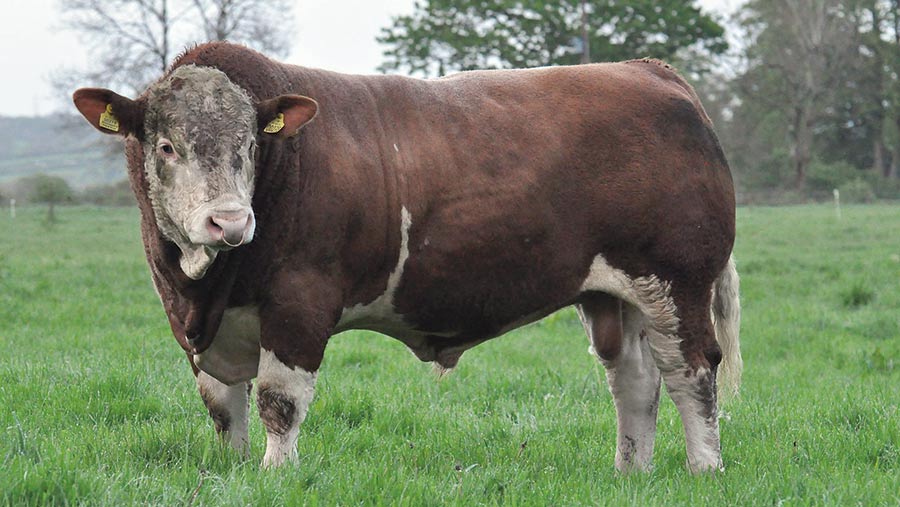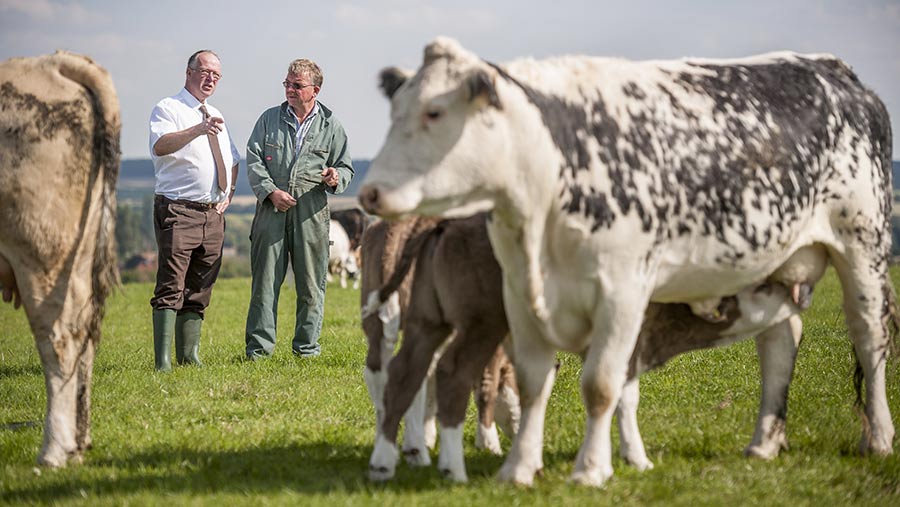Why calving ease should be suckler herd priority

Selecting bulls with a positive calving ease estimated breeding value (EBV) should be a priority for suckler producers who are aiming to improve herd efficiency, a study has shown.
Researchers at Harper Adams University compared Simmental progeny from a top 1% terminal index bull and a Danish-bred polled bull with a top 10% index.
See also: Feed Efficiency EBV available for Limousin breeders
The two bulls were based at Ian Willison’s 115-head autumn-calving Simmental cross British Blue suckler herd in Nottinghamshire.
1. Woodhall Ferrari 14 (terminal index +126 – top 1%)
- Harder-calving bull, but with good growth EBVs
- Calving ease -3.9% (bottom 20% for the breed)
- Calf birthweight EBV +5.4kg (bottom 1%)
- Carcass weight EBV +69kg (top 1%)
- Eye muscle area +6.4sq cm (top 1%)
- Fat depth -1.3mm (bottom 1%)
2. Sneumgaard Imperator (polled Danish bull, terminal index +92 – top 10%)
- Very easy-calving bull with good growth rate and fat figures, meaning his calves should suit cereal and forage-based systems
- Calving ease +13.4% (top 1%)
- 400-day growth +74kg (top 10%)
- Carcass weight +55kg (top 10%)
About the trial
The Simmental cross British Blue cows were inseminated at random with one of the bulls in the winter of 2016, followed by a sweeper bull.
The bull calves were intensively finished at just over a year old in 2018. Creep was offered to the calves from four weeks old. Heifer calves were not fed creep after Christmas.
Bull calves were weaned when the cows were turned out in early April and intensively finished on a blend and good-quality maize silage total mixed ration (TMR) fed on a 60:40 ratio on a dry matter basis.
The TMR had a dry matter (DM) of 54%, 12.4ME, 16.1% CP (in DM) and 28% starch (in DM). The silage and blend intakes averaged 13.6kg (4.2kg DM) and 7.0kg (6.2kg DM) a head a day, respectively. Selection for slaughter was based on age.
When a bull had reached one year and a trailer load of six bulls were ready, they were sent to slaughter, with the youngest killed at 365 days.
Key findings
-
The calves from Woodhall Ferrari – the top 1% index bull – recorded 23.6kg heavier carcass weights, but were slaughtered 10 days older on average. After deducting increased feed costs, this was worth £39 a bull.
-
The financial benefit of a slightly easier calving with Imperator-bred calves, and benefits of not dehorning (Imperator was polled), outweighed the lower carcass weight.
-
The performance of the progeny from both bulls was outstanding. The finishing performance of the bulls mirrored the growth and carcass EBVs of the sires (see “Slaughter performance of the bull calves”).
-
Ferrari has a significantly higher carcass weight EBV (+69 v +55kg) and his sons recorded higher carcass weights of 23.6kg. However, Imperator sons recorded relatively similar daily liveweight gains due to their lighter birthweights and the fact they were slaughtered 10 days earlier. Carcass conformation and fat scores were similar.
-
For all calves bred from the herd, including those from the sweeper bull, the mean calf birthweight and 200-day weights were 44.7kg and 336kg, respectively – equating to a daily liveweight gain of 1.46kg and an efficiency factor of 51.5%, based on the mean cow weight of 653kg. The target cow efficiency factor is 50%, which very few suckler producers achieve.

Simon March (left) and Ian Wilson © Jim Varney
Explaining the results, Simon Marsh, principal lecturer and beef cattle specialist at Harper Adams, says the trial clearly shows bulls perform consistently when their EBVs had reasonably high levels of accuracy.
“The number one priority for any farm, though, should be selecting bulls with good easy calving figures. Through easier calving, the cows can calve down in fitter condition and get back in calf easier, and this overrides the growth benefits that a slightly better-growing, but harder-calving bull like Ferrari can offer.”
Mr Marsh adds: “The bulls were finished at just over 12 months old, which almost produces a ‘lifecycle of perfection’, with the old calf being slaughtered when the new one is born.
“Money can be made in suckler production and it’s about making sure genetics, breeding and health of the animal is right.”
Farmer Ian Willison says although Ferrari has good growth rates, he would choose Imperator due to his easy calving figures.
“The Ferrari calves had a higher mortality rate and this had a negative effect on the following conception rate of the cows. This is the first year we have calved to very easy-calving bulls.
The females had an incredibly easy calving and the conception rates have subsequently been fantastic after calving, with 85% holding to first service AI,” Mr Willison explains.
This means most cows should calve in first three weeks next year.
“There is also tremendous scope within the double-plus calving bulls (positive calving ease direct and daughters) to produce all types of male and female progeny to fulfill the role of the ideal suckler herd,” he adds.
However, Mr Willison stresses the importance of having the right cow. “While using a high-EBV bull is important, we can’t forget the breeding females that are made from generations of high-EBV genetics, whatever the breed.
“I cannot stress enough the importance of having the right cow for your farm to produce the right calf for the right market. There are too many cows bred ‘too terminal’, and that’s causing inefficiency.”
Calving characteristics and growth rates to 200 days |
||||
| Sire | Ferrari (top 1% index) | Imperator (top 10% index) | ||
| Calf sex | Bull | Heifer | Bull | Heifer |
| Gestation length (days) | 293 | 298 | 288 | 287 |
| Calving ease (1-6) | 1.50 | 1.0 | 1.32 (15.8% assistance) | 1.0 |
| Birth weight (kg) | 54.0 | 48.0 | 45.3 | 39.7 |
| 200-day weight (kg) | 405.4 | 305.8 | 387.1 | 286.0 |
| Daily liveweight gain – birth to wean (kg) | 1.76 | 1.29 | 1.71 | 1.23 |
Calving ease score: 1= unassisted, 2= easy pull, 3 = hard pull, 4= surgical, 5= abnormal presentation, 6 = elective surgery.
Slaughter value and feed costs |
||
| Sire | Ferrari (top 1% index) | Imperator |
| Carcass price (p/kg base at £3.50/kg)* | 3.53 | 3.59 |
| Carcass value | £1,457.85 (+£60.92) | £1,396.93 |
| Increase in feed costs | £21.43 | |
| *Includes penalties for overweight carcasses | ||
Slaughter performance of the bull calves |
||
| Sire | Ferrari (Top 1% Index) | Imperator |
| Slaughter age (months) | 12.6 (384 days) | 12.3 (374 days) |
| Slaughter weight (kg) | 725 | 683 |
| Daily liveweight gain wean to slaughter (kg) | 1.71 | 1.76 |
| Daily liveweight gain from birth (kg) | 1.75 | 1.71 |
| Carcass weight (kg) | 413.1 | 389.5 |
| Carcass DG from birth (kg) | 1.08 | 1.04 |
| Conformation score (1-7)* | 5.0 (-U) | 4.0 (-U) |
| Fat class (1-7) | 2.9 (3) | 3.0 (3) |
| *Europ carcass classification: Conformation: P+=1 and E=7. Fat class: 1=1 and 5H=7 | ||
EBVs to help you breed easy-calving fast-growing calves
- Birthweight (kg) Select negative values, as this will result in a lighter calf at birth
- Gestation length (days) Select negative values, as the shorter the gestation length, the smaller the calf will likely be
- 200- and 400-day growth (kg) Select positive figures – you want to use a “curvebender bull” (this is a bull that produces smaller calves that go on to grow fast)
- Calving ease (%) High positive values – this equates to more unassisted calving’s of a bull’s direct progeny
